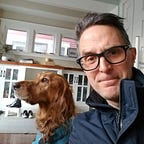On the Origin of Niches
in life and trading … part one
If you’ve heard about the toxoplasma gondii parasite, you know that life on earth can evolve in very peculiar ways. Toxoplasma gondii (‘Toxo’) is a single-celled parasite whose definitive host is the cat: the parasite requires the intestinal tract of a feline host to mature and reproduce. Toxo can move between mammalian hosts quite readily. In rats, it fills an interesting niche. It affects the rat brain to reduce its fear of feline urine. Instead of fleeing from the smell, infected rats have a sexual attraction to it. So infected rats are more likely to get eaten by cats and the parasite is back in the feline intestine to begin the cycle again. That is only the beginning of the mystery of the Toxo parasite. Evolution is a wonder.
Charles Darwin and Alfred Wallace’s natural selection (1859) is now overwhelmingly supported by evidence. It is the primary mechanism of evolution and is at the root of the extreme beauty and diversity of life. According to the theory, organisms best adapted to their environment produce offspring with the same heritable traits responsible for their own success. It is believed to be the most crucial step in the process of evolution — “survival of the fittest”.
Would it be fair to say natural selection is the mechanism behind the evolution of the adjacent set of opportunities that life evolves into? The complex web of life, and its surrounding environment, is the context for evolution. It is the set of all materials, energy sources and uses, processes, constraints, all the species, the existing niches that they fill and, importantly, all the unknowable niches yet to arise and be filled by evolving life forms. The ecosystem and its uncountable set of opportunities is in constant flux. The context for evolution is in constant flux. The boundaries constraining what is possible are perpetually dissolving and reforming anew.
Take the example of the domestication of the wolf over 15,000 years ago. Before humans began to co-evolve with wolves, one can imagine a relationship based more on mutual fear, than on mutual reliance. However, the opportunity for a deep interspecies relationship came into being in the environment, a niche for both mankind and wolves that would eventually see dogs become so important to humans that dogs are buried in family plots at cemeteries. Dogs are so much a part of the modern human experience that people search for dogs more than God on Google Trends.
Now that dogs and humans are inseparable, mutually-beneficial opportunities abound such as the opportunity for seeing-eye dogs to aid the blind, service dogs to support autistic children and lonely dogs and lonely people to comfort each other on a Sunday morning in a warm home. Many thousands of people globally depend on the human-dog relationship to provide for their families. Dog shows, dog breeding, dog grooming, dog food, dog health and health insurance for dogs have all emerged as opportunities for humans to make a living. Many dogs have easier, happier, healthier lives with loving owners.
On the other hand, it has always been the case that certain diseases plague either dogs or humans specifically. Today, in close quarters, some parasites, fungi, bacteria and viruses have evolved to afflict both humans and dogs at once. Ringworm, caused by a fungus, the rabies virus and tapeworm parasites are examples.
Let’s put our question back in focus. If a new organism arises in the environment, is there any way to predict what new opportunities might emerge as a result? Stuart Kauffman, author of ‘Reinventing the Sacred’ asked the related question, ‘What are the possible uses of a screwdriver?’. Any thoughtful response must be a long list of creative functions beginning with something like, ‘installing a smoke alarm’, ‘opening a paint can’, ‘scratching an itchy back’. In 1902, ‘fixing the propeller on an airplane’ was not a possible use for a screwdriver. By 1904 it was. A new niche emerged in the environment. The list of new opportunities generated by a change in the environment can not be known in advance. As context continually changes, functions materialize and fade away. Like this, life evolves continually into an unknown adjacent possible, full of opportunities that we can not predict in advance.
I often wish that I could have a moment to chat with Darwin or Wallace about the boundless creativity of the evolution of species into a myriad of niches. Instead I lead a comparably mundane work-life assisting in the evolution of creative investment products into innovative strategies. I am occasionally lucky enough to be visited by their ghosts.
